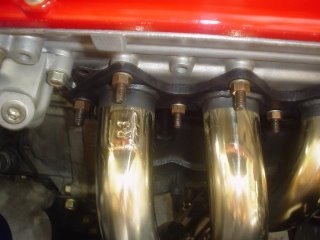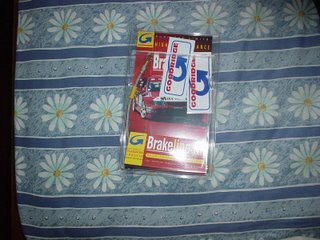It is important to remember that an engine is essentially a big air pump. While the cams and ports work to ingest the air the exhaust must be there to maintain the vacuum effect. While forced induction or turbocharged engines use an air compressor that is driven via the exhaust to spool the air into the engine, a Normally/Naturally Aspirated engine is totally relying on Mother Nature and the Laws of Physics. But remember what goes into the engine, must also come out. Header tuning is getting the length, diameter and merge of the pipes right to maintain or even enhance this air pump effect via scavenging. Get the combination wrong and you lose power. Simple as that. I'm not going to go into detail on header theory for my post though. You can read bout it more at
Burns Stainless . Tuan aka Michael Delaney has also written an excellent on header at the
Team Integra website.
With the build engine being used by the SP, I was really looking for a long primary 4-2-1 header but this was not to be despite numerous emails to TH Motorsport in the UK. For one thing they wanted to sell me the header used in the Kermit M21 racecar for 550 GBP not including shipping. The other was when I said "Yes, I'm ok to pay" they never got back to me despite several emails. Believe it or not. Talk about poor customer service. I can tell you that with the spec of the 4G93 engine used on the SP, the 4-2-1 Hot Bits header I'm using is the
No.1 power limiter despite extensive porting. Anyway fast forward 2-3 years and my bro, a one Adian Yein Khalid from
R3 (Race Rally Research) aka Proton Motorsports finally tells me they have a decent header for me. This is the extended 4-1 Stage 3 stainless steel header for highly tuned/race spec engines and believe it or not the retail price was an unbelievable RM630. Very very reasonable considering most Jap spec headers like the
Toda,
Jun for Honda engines are 2+ to 3 or 4K. The long primary
Hytech 4-2-1 header with anti-reversion chambers costs RM6-7K+. What price workmanship and quality? The price is simply too good to be true considering the fact that
RPW from Australia was trying to sell me a similar spec header but in mild steel for nearly RM2K!!! R3 has extensively dyno tested this header and the gains are 6hp over 6000rpm for an engine with standard cam. On a race spec engine with 272 duration cams, the gains were much more at 4-5hp across the rev range from 3000rpm onwards. So much for a 4-1 header only making power at the top end huh? I've personally also seen a
Mugen 4-1 header making 6hp across the rev range compared to a stock 96 spec DC2 Integra Type R header. For 98 year Honda actually went to a extended 4-1 header for the ITR. Goes to show that there is not such thing as a universal header for all engine specs. Match the header to the tune of your engine.
Now if you wanna know why stainless steel is so much better than el cheapo mild steel for header construction, you can read it
here. Would have loved an Inconel or Ti header but I doubt I'll ever save up enough. Anyway, a couple phone calls and sms messages and foolah the header was at my doorstep. Anyway that was way back in August last year and I'm now using the second generation improved production quality header at the same list price. Picture below of the R3 header ready for installation. As stated the header tubes including the flex joint or "pineapple" is made from stainless steel. The top inlet flange and single outlet pipe flange are however made from mild steel and finished with high temp black paint.

Compared to the earlier spec header I was testing out previously, this header uses thicker gauge stainless steel so should be much more durable in the long run. R3 have also tried to improved on the quality and welding of the "R3" logo on the no.1 header tube.
Picture below of the earlier spec header with "R3" logo.

Picture below of the latest spec header. Nice try at robotic "fish scale welds"

I'm using a better quality header gasket for my latest install. Picture below of how large the 4-1 header is compared to a standard 4-2-1 Hot Bits header. Not only are the primaries much longer on the R3 4-1 but larger in diameter too. Sorry bout the picture quality. Shakey hands when taking the pix..

Picture below of how much the R3 Stage 3 4-1 header extends down below the oil sump. If your car's slammed you might want to be very careful especially when going over bumps.

Being like any other mass production header there is quite a lot of excess weld left on the flanges. This should be remove via a dremel as it impedes exhaust flow.


Takes about 2-3 hours max to install the header including porting the flanges. Installation was pretty much bolt-on though some muscle was needed to line everything up properly. The power steering pump and radiator fan will have to be removed during the installation. A hydraulic lift is a must and the header should be removed and installed from the bottom of the car rather than on top. Much easier this way. Oh, and please wipe the header of your greasy oily fingerprints before starting up the car else these will permanently be on your header leaving unsightly stains and marks. Picture below of the header turning a nice gold hue after a few power runs.

So I guess most of you all are wondering how is the power after the header install? All I can say is that the power gains are everywhere on my engine and not just at the top end. Top end of course is much much better making so much easier for the SP to pull to it's redline. I've yet to dyno the SP and probably won't be doing so unless they can have a dyno in Penang but I'm willing to bet anyone that the gains from the header are a lot. Wouldn't be surprise if it made more than 5-6hp additional over the standard
Hot Bits 4-2-1 header.
As I've posted in
TMM previously "Took the car for a nice drive on Sunday morning to butt dyno. Took the car to 3000rpm, 4000rpm, 5000rpm... 9000rpm!!! Whoa!!! The car keep pulling and pulling.. Top end pull is damn sweet and definitely way more than my
Hotbits 4-2-1. Had a nice time whacking the car left right centre... Exhaust note also sounds different and even boxer note like. Must be due to the different config of the primaries. I'm pretty sure the max power output way up is bout 3-5hp more but short of dynoing the car I can't confirm bout gains or losses anywhere in the curve.."
BTW, here' a picture of the Super 1600 (Junior WRC) Citroen C2's engine bay. Notice how long and large the header primaries are for top end power.

I'll like to end this post by saying that the gains are what I felt for the SP. This does not mean that the effect will be the same for every 4G93P. In fact R3 does not recommend this header to 4G93Ps running the R3 Stage2 cams as apparently there will be a power loss. As I've stated before, match the header to your engine spec. If you're unsure call R3. They're a pretty helpful bunch of folks.
I would still like to try a 4-2-1 long primary header one day. This is really the best config for engines running big cams and big compression. Proven many times over. Hopefully R3 will make one for me. Apparently they did try a prototype LP 4-2-1 but this was too expensive to mass manufacture. IMHO I personally wouldn't mind paying RM1.5K or more for a header if there are gains and the workmanship is top notch. However this is just me and maybe a couple of buddies and hardcore mod enthusiasts and not the majority. In fact I wouldn't be surprised if people complained RM600+ is too expensive for a header. Such is the state of our tuning industry. Sorry for the rant..



























